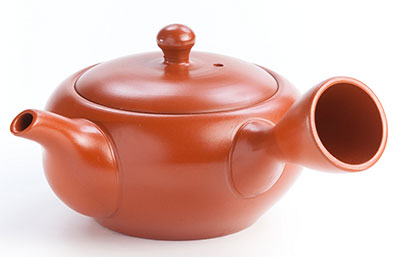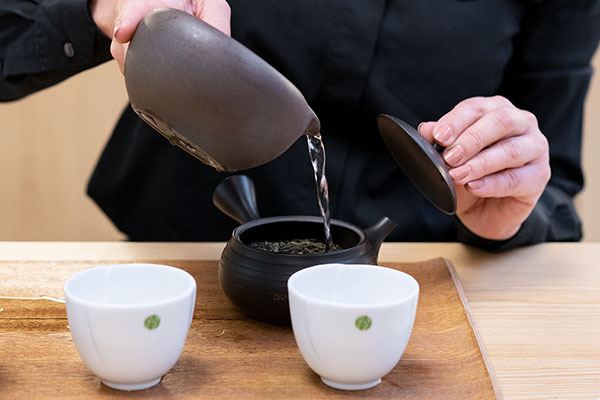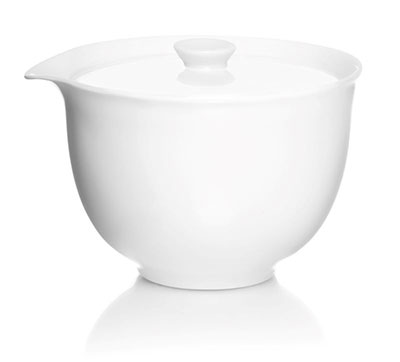We ship all over the world
Kyysu and Shiboridashi
Kyysu and Shiboridashi are accessories traditionally used for the preparation and the infusion of Japanese green teas, Gyokuro, Sencha and Tamaryokucha in particular.
Kyusu

A kyusu teapot generally has a volume of 12 fl. oz. (36cl), but some contain just 3-5 fl. oz. (10-20cl) for very high quality teas. The cups used are small, of around 3 fl. oz. (10cl). A yuzamashi pot can also be used to cool the water before pouring it over the tea leaves.
The kyusu is traditionally used to prepare Japanese green tea, particularly gyokuro, sencha and tamaryokucha.
Using Kuysu
Like a traditional teapot: using the same quantity of tea leaves and infusion time.
This method is ideal for preparing small quantities of high quality tea while offering the pleasure of using a special teapot.
Using the Japanese method: the tea leaves can be infused several times.
For this method, infuse the leaves for 2 minutes the first time, 1.5 minutes for the second infusion, and 1 minute for the third.

How to use Kyusu the Japanese way?
- Prepare the accessories: 1 kyusu, 3 cups, tea leaves and tea measure.
- Heat the water in a kettle to just below boiling point.
- Place the tea leaves in the pot.
- Fill with 2 cups of hot water for a sencha or 1 cup of hot water for a gyokuro.
- Cool the water by transferring it from cup to cup using the remaining empty cup. Each time, the water temperature is lowered by around 10°C. This ensures the water is at the correct temperature.
- Pour the contents of the cups over the leaves once the water is at the right temperature.
- Leave to infuse.
- Pour the contents of the kyusu into the 3 cups.
- Repeat the process, reducing the infusion time by a third each time.
Shiboridashi

The Shiboridashi is a Japanese accessory that is mainly used for infusing Japanese green teas, such as "Gyokuro", which is a particularly complex and rich green tea
As this type of tea is infused at quite a low temperature (between 50 and 70°C), there is no burn risk when using the Shiboridashi.
The Shiboridashi's small size is perfect for obtaining a liqueur which brings out all the subtleties of Japan's fine green teas. Its white porcelain perfectly reproduces all of its aromatic notes, while also showcasing the liqueur's colour. Porcelain is a type of ceramic that is highly renowned for evenly distributing heat, which allows for ideal tasting, particularly in the case of green teas. The Shiboridashi features thin grooves around the spout, so that the tea leaves can be filtered.
Traditional Japanese tea preparation methods take inspiration from a ceremony known as Senchadō.As with the Cha No Yu ceremony, Senchadō is a ritual that is part of the "way of tea" (chadō). The difference between the two ceremonies lies in the tea used: Cha No Yu is a ceremony centred around Matcha, while Senchadō is focussed on loose leaf teas (Gyokuro, Kabuse Cha, Sencha).
The traditional technique based on Senchadō may be practised in two different ways:
either using a Kyusu: the traditional Japanese teapot
or using a Shiboridashi: a utensil which shares similarities with a Houhin and resembles the Chinese lidded bowl known as a Gaiwan
Instructions for preparing Gyokuro
- Directly place 15 grams of tea in the Shiboridashi. Add 15 cl of water at the right temperature (generally 50°C to 70°C, depending on the tea), making sure to carefully pour the water onto the sides of the utensil so as not to burn the leaves.
- 1st infusion: 1 minute
- 2nd infusion: empty it straight away, just after adding the water
- 3rd infusion (and so on): 30 seconds, while gradually increasing the temperature of the water
- It is important to pour the liqueur in its entirety during each infusion in order to ensure that the infusion does not continue.
- The last drop is always reserved for the guest of honour!
Instructions for preparing Sencha
- Directly place 7 grammes of tea in the Shiboridashi. Add 15 cl of water at the right temperature (70°C), making sure to pour it in a circular motion so that the infusion occurs at the bottom of the leaves.
- 1st infusion: 1 minute
- 2nd infusion: empty it straight away, just after adding the water
- 3rd infusion (and so on): 30 seconds, while gradually increasing the temperature of the water
- It is important to pour the liqueur in its entirety during each infusion in order to ensure that the infusion does not continue.
- The last drop is always reserved for the guest of honour!
Instructions for preparing iced tea
It is also possible to make cold brew tea by replacing the water with ice cubes. The infusion is finished when the ice cubes have completely melted; you will obtain a concentrated, intense liqueur that is as rare as jade dew.